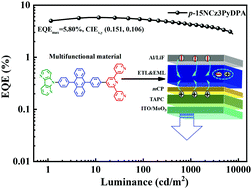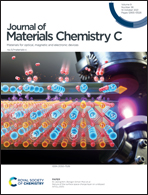Exploiting asymmetric anthracene-based multifunctional materials based on a “bulky peripheral modification” strategy for constructing simplified efficient deep-blue fluorescent OLEDs†
Abstract
An asymmetric bulky periphery enveloping strategy is proposed to delicately manipulate molecules for the construction of novel multifunctional organic electronic materials. Here, 9,10-diphenylanthracene (DPA) was selected as the framework with both carrier-transporting channel and blue emission, with bulky 1,5-diazarcarbazole (15NCz) and terphenyl/terpyridine grafted on it. Two asymmetric anthracene-containing derivatives, namely 5-(4-(10-(5′-phenyl-[1,1′:3′,1′′-terphenyl]-4-yl)anthracen-9-yl)phenyl)-9H-1,5-diazarcarbazole (p-15NCz3PhDPA) and 9-(4-(10-(4-([3,2′:6′,3′′-terpyridin]-4′-yl)phenyl)anthracen-9-yl)phenyl)-9H-1,5-diazarcarbazole (p-15NCz3PyDPA), were first designed and synthesized. The bulky periphery groups 15NCz and terphenyl/terpyridine with large steric hindrance could efficiently increase the molecular space volume and diminish the intermolecular π–π stacking, which helped to promote the photoluminescence quantum yield (PLQY). Meanwhile, the introduced terphenyl/terpyridine manipulated the charge-carrier-injecting and bipolar-transporting characteristics. A detailed device engineering study was carried out, where it was found that p-15NCz3PhDPA- and p-15NCz3PyDPA-based unilateral homogenous devices could achieve deep-blue emissions with Commission Internationale de L’Eclairage (CIE) coordinates of (0.149, 0.081) and (0.151, 0.106) at a voltage of 6 V, and a narrow full width at half maximum (FWHM) of ∼52 nm and an impressive maximum external quantum efficiency (EQEmax) of 5.87% and 5.80%, respectively. These new multifunctional materials performed better than the commonly used electron-transporting material TPBi. Accordingly, this work sheds light on designing multifunctional organic electronic materials, particularly offering a sensible way to construct efficient low-power-consumption simplified deep-blue fluorescent OLEDs.



 Please wait while we load your content...
Please wait while we load your content...